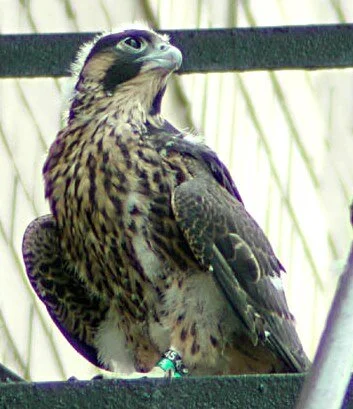Hatching
Photo: M. Hennen
Because incubation is delayed until the clutch is nearly complete, most eggs hatch within 1-2 days. For the Chicago area, hatching usually begins around Mother's Day. This is also the time period where the adults are most defensive of the natal site. Males will spend most of their time hunting in order to feed the female and chicks. Feeding is frequent as the chicks can only handle small amounts of food at a time.
Brooding
photo: M. Hennen
For the first 7-10 days females will brood the chicks, which means tucking them under her wings for warmth or shading. Feeding is frequent as the As the chicks rapidly mature, they no longer fit under the female and are large enough to thermo-regulate on their own.
Banding
photo: M. Hennen
Banding occurs when the chicks are around 21-24 days old. At this stage the chicks have reached full size insuring that we can place bands on the legs the bird will not outgrow it. Secondarily, the chicks still lack flight feathers. This means we can retrieve the chicks from the nest without the risk of premature fledging. Chicks receive two bands that bracelet their lower legs; one on the right and one on the left. These bands are unique to the individual. They allow scientists to study longevity and dispersal of individuals.
Nestling: 35 days
Photo: K. Hirabayashi
For the three weeks following banding, the chicks become fully feathered out and are extremely mobile. During the week before fledging (taking their first flight) the young falcons will do a lot of wing flapping to strengthen their muscles.



